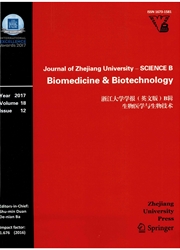

 中文摘要:
中文摘要:
客观大部分骨头缺点修理与增加兴趣集中于把基因 transfection 与设计技术的织物相结合仍然是临床、科学的挑战。这研究的目的是在增长和骨头髓的 osteogenic 区别上调查结缔组织生长因素(CTGF ) 的效果间充质的干细胞(MSC ) 。一个表示 CTGF 原生质标志(pCTGF ) 被构造的方法和进 MSC 的 transfected。然后骨头的表情形态发生相关的基因,增长率,碱的磷酸酶活动,和矿化作用被检验评估 CTGF 修改基因的 MSC 的 osteogenic 潜力。CTGF 的结果 Overexpression 在 pCTGF-MSCs 被证实。pCTGF transfection 显著地提高了 pCTGF-MSCs (P【0.05 ) 的增长率。CTGF 在控制(P【0.05 ) 上在房间移植导致了 7.5 褶层增加。pCTGF transfection 提高了骨头矩阵蛋白质的表示,例如骨头 sialoprotein, osteocalcin,和骨胶原类型我在 MSC。碱的磷酸酶(高山) 的层次在第一 and 的 pCTGF-MSCs 的活动第二星期比在有教养的 MSC 的那些高是 4.0 褶层和 3.0 褶层 OS 中等,比那些显著地高 mock-MSCs 和正常控制 MSC (P【0.05 ) 。在 MSC 的 CTGF 的 Overexpression 提高了能力形成使矿物化的小瘤。CTGF 的结论 Overexpression 能改进 MSC 的 osteogenic 区别能力,并且 CTGF 修改基因的 MSC 作为骨头织物工程的新奇房间资源潜在。
 英文摘要:
英文摘要:
Objective: Large segmental bone defect repair remains a clinical and scientific challenge with increasing interest focusing on combining gene transfection with tissue engineering techniques. The aim of this study is to investigate the effect of connective tissue growth factor (CTGF) on the proliferation and osteogenic differentiation of the bone marrow mesenchymal stem cells (MSCs). Methods: A CTGF-expressing plasmid (pCTGF) was constructed and transfected into MSCs. Then expressions of bone morphogenesis-related genes, proliferation rate, alkaline phosphatase activity, and mineralization were examined to evaluate the osteogenic potential of the CTGF gene-modified MSCs. Results: Overexpression of CTGF was confirmed in pCTGF-MSCs. pCTGF transfection significantly enhanced the proliferation rates ofpCTGF-MSCs (P〈0.05). CTGF induced a 7.5-fold increase in cell migration over control (P〈0.05). pCTGF transfection enhanced the expression of bone matrix proteins, such as bone sialo- protein, osteocalcin, and collagen type I in MSCs. The levels of alkaline phosphatase (ALP) activities ofpCTGF-MSCs at the 1st and 2nd weeks were 4.0- and 3.0-fold higher than those of MSCs cultured in OS-medium, significantly higher than those of mock-MSCs and normal control MSCs (P〈0.05). Overexpression of CTGF in MSCs enhanced the capability to form mineralized nodules. Conclusion: Overexpression of CTGF could improve the osteogenic differentiation ability of MSCs, and the CTGF gene-modified MSCs are potential as novel cell resources of bone tissue engineering.
 同期刊论文项目
同期刊论文项目
 同项目期刊论文
同项目期刊论文
 期刊信息
期刊信息
